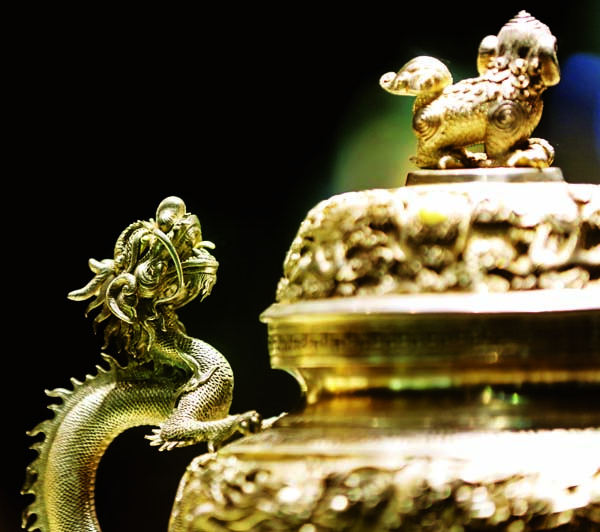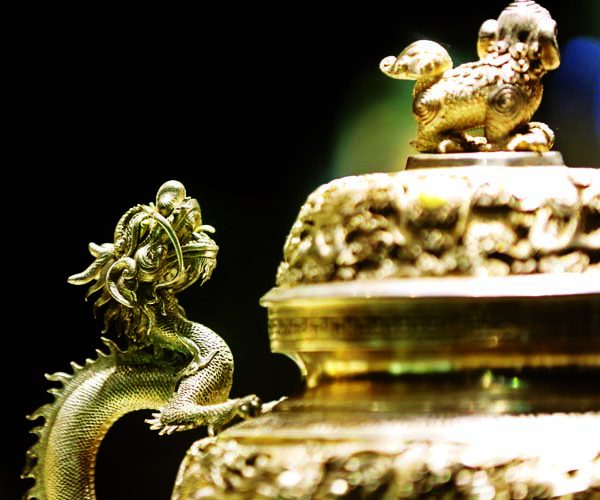(No.5, Vol.8,Oct-Nov Vietnam Heritage Magazine)
An worshipping item used by royal family of the Nguyen Dynasty (1802-1945)




A crown, a royal seal, a box, and a sword used by kings under the Nguyen Dynasty
Dragons and phoenixes are among the four sacred animals in Vietnamese culture, the other two being kylins and turtles. In the group of four, dragons are always at the top position.
This royal creature has been introduced to audiences in an ongoing exhibition of treasured items created in the era of the Nguyen Dynasty (1802-1945), currently being held in the city of Hue.
Dragons first appeared in Vietnamese culture in the Dong Son era, which occurred from 1000 BC to the 1st Century AD. At first, the dragons were depicted only in simple structures, and they were often shown in pairs.
The imaginary animal became complicated in structure and patterns in art and cultural works when the country gained independence from feudal China, particularly in the eras of the Ly Dynasty (1010-1225) and the Tran Dynasty (1225-1400).
Experts said the eras’ dragons experienced a breakthrough in structure and art values compared to those existing in China at the time. They also carried the profound identity of Vietnamese culture.
Dragons later became vivid and typical in the era of the Nguyen Dynasty, the last monarchy in the country. Along with dragons carved intricately on wooden items, pottery makers in this era succeeded in creating dragons in different styles on items used for ritual and royal buildings. They might appear alone, in pairs or in groups.
Materials for carving or embossing dragons were diversified, from items for worshipping altars, poles in pagodas and temples to stone panels, and ceramic items as well as gold, ivory, enamel, and silk items.
Dragons in this era represented the monarchy and they were presented in many places and items owned by the royal family.
They were engraved in the objects showing the supreme power of the kings, including the royal hall chairs, seals, swords, scepters and crowns.
The crowns, for instance, were categorised in several types for official meetings, daily use, and ritual ceremonies, but they were all engraved with up to 35 dragons in tiny structures.
Royal costumes designed for kings also had embroidered patterns of dragons on their laps.
Dragons were present on all items designed for kings and are rarely seen on those for queens. Phoenixes were popular for queen and princess items and sometimes carved on the items for male members of the royal family as well.
Experts said those sacred animals not only represented for the monarchy but they also carried the desires of a better life of the artisan who created them, as well as the artistic side of the products, reflected by the powerful beauty of kingly items and the utmost charm of queenly items.
At the exhibition, which started in early September and will end 5 December, more than 80 precious items carved with dragons and phoenixes are on display.
The exhibition is taking place at the Royal Antiquities Museum at 3 Le Truc Street, which is located on the right hand side of the former royal palace in the city of Hue.
The exhibits include those owned by the Hue Museum of Royal Antiquities, a place conserving almost all treasures left by the dynasty in Hue, and other items borrowed from the Vietnam Museum of National History in Hanoi.
Hue Monuments Conservation Centre, a local government body managing relics built by the dynasty in the city, said all displayed items were from the dynasty.
Phan Thanh Hai, the centre director, said the exhibits were used in dressing, daily use and administration by kings and other royal members. They are made of rare, precious materials including gold, silver and precious stones.
Every item in the exhibition is engraved with dragon or phoenix patterns, using techniques of carving or embossment.
Hai said the exhibition was part of the efforts to showcase the luxurious effects owned by the kings as well as the quintessence in craft by Vietnamese artisans in ancient times.

